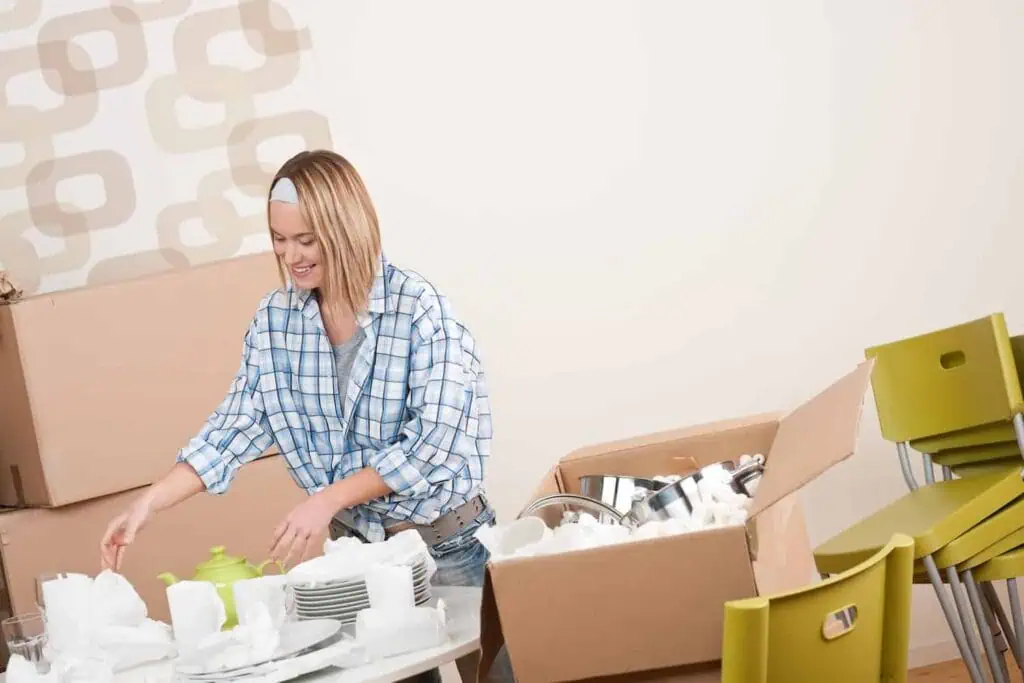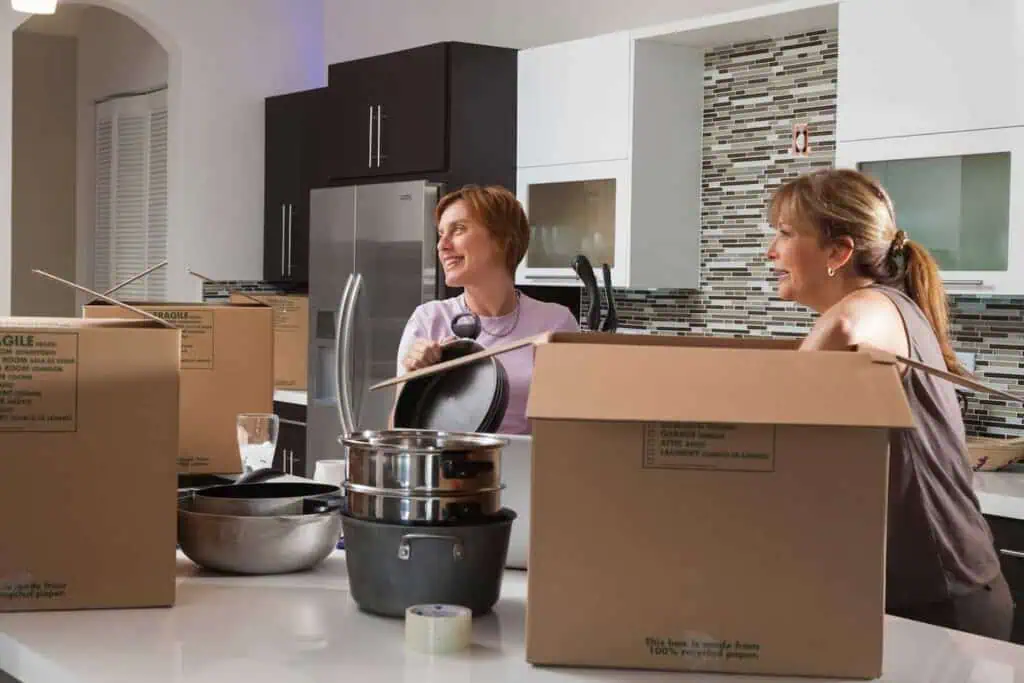Packing your kitchen for a move can feel like a game of culinary Tetris, especially when it comes to pots and pans. These heavy, oddly shaped essentials don’t exactly fold up or fit into boxes neatly. And, if you don’t pack them right, you could end up unpacking a mess of scratches, dents, bowed lids, and chipped handles.
Our handy guide walks you through the process step by step so you can pack like a pro and keep your prized cookware safe while you’re on the road.
Supplies Needed to Pack Pots and Pans Safely
Before you start wrapping and boxing your cookware, you’ll want to gather the right materials. Using the proper supplies helps protect your pots, pans, and lids during transport and makes packing (and unpacking) quicker, cleaner, and less stressful.
Let’s look at what you’ll need to pack your pots and pans the right way:
- Medium-sized moving boxes: This size is typically strong enough to handle the weight of cookware without breaking apart or becoming too heavy to carry when full
- Packing paper or newsprint: Great for wrapping stainless steel pots, nonstick pans, and separating nested sets without scratching their surfaces
- Bubble wrap or foam padding: Best for glass lids, ceramic pans, Dutch ovens, or enameled cookware that needs more protection
- Dish towels, oven mitts, or soft linens: These can double as padding and help fill gaps between stacked pots or pan handles
- Packing tape: Seals your boxes securely, which is especially important for heavier sets of pots and stacked pans
- Permanent marker: Use it to label boxes with “Kitchen pots and pans,” and flag anything fragile or heavy
- Stretch wrap or plastic bags: Helpful for bundling lids with their matching pots and keeping sets of small pans together
You can find these items at local hardware stores, big-box retailers, or moving supply outlets. Many people also reuse what they already have at home — just be sure whatever you use is clean, strong, and protective.
Step-by-Step Guide for Packing Pots and Pans
With your supplies ready, it’s time to get hands-on. The goal is to protect your pots and pans from banging into each other, shifting inside the box, or damaging fragile coatings and lids.
Here’s how to pack pots and pans for a move like the pros in 10 easy steps:
- Clean and dry everything: Make sure every pot, pan, and lid is clean, dry, and residue-free
- Sort by size and type: Group large stockpots with other oversized cookware and small pans with each other. Keep delicate or nonstick items separate from cast iron or metal
- Wrap each item individually: Use packing paper or dish towels to completely wrap every pot and pan, including lids. Pay special attention to handles, spouts, and surfaces that could scratch
- Nest with care: Nest similar-sized pots and pans together, placing padding between each piece. For example, if you’re stacking frying pans, use a towel or paper between each one to prevent scraping
- Line the box: Add a cushion of crumpled paper, foam padding, or even folded kitchen towels to the bottom of your box before placing anything inside
- Place cookware strategically: Heavier items, such as cast iron or Dutch ovens, should go at the bottom of the box. Layer lighter pans, saucepans, or nonstick pots on top
- Separate and wrap lids: If you’re moving with glass lids, wrap each one separately in bubble wrap or foam. Store them vertically, side by side, or in a well-padded lid-only box
- Fill all gaps: Use extra towels, oven mitts, paper, or even silicone trivets to fill gaps between your pots and pans. A snug box means less jostling during the move
- Seal and reinforce the box: Use high-quality packing tape to close and reinforce the bottom and top seams. Reinforce the sides if you’re packing a heavier load of cookware
- Label clearly and completely: Label each box and note if fragile items like glass lids are included. Add “Heavy: Lift with care” if your box is on the dense side
Taking your time here means fewer dings, no mystery boxes, and way less frustration in the unpacking phase.
How to Transport Pots and Pans Safely
Once your cookware is packed, the next step is figuring out how to transport it safely from point A to point B. Even well-packed pots and pans can be damaged if they aren’t handled with care.
“Unbox your daily cookware first — a frying pan, a medium pot, an oven pan, a lid or two, and a spatula. That will get you through your first few meals.”
Here are some essential tips for moving with pots and pans:
- Keep cookware boxes upright: Store boxes on their base to keep stacking pressure off fragile lids and prevent pans from shifting and tipping.
- Don’t stack furniture on top: Avoid crushing boxes filled with heavy or oddly shaped pots and pans by placing them on top of softer items, such as bedding or clothes.
- Use padding in the vehicle: Secure your cookware boxes with moving blankets or straps so they don’t slide around the back of a truck.
- Mind your materials: Extreme heat can warp nonstick pans or melt plastic handles. Avoid leaving cookware in hot storage pods or unventilated trailers for long periods.
If you’re hiring movers through HireAHelper’s marketplace, you can include handling notes so they know which boxes need a gentler touch.
Unpacking and Organizing Your Pots and Pans
Once you arrive, the kitchen is usually one of the first rooms people want to set up. The trick is to start with the most frequently used items and wait to unpack the rest. For example, you probably don’t need your slow cooker right away, but you likely do want to know where your espresso machine and pasta pot are.
Here’s how to quickly and safely unpack your pots and pans after moving:
- Start with the basics: Unbox your daily cookware first — a frying pan, a medium pot, an oven pan, a lid or two, and a spatula. That will get you through your first few meals.
- Inspect for damage: Look for chips in enamel, scratches on nonstick pans, or broken handles before putting things away.
- Give everything a quick rinse: Even if your pans were clean when packed, moving boxes can collect dust, lint, or cardboard residue.
- Organize by use and access: Place frequently used pots and pans in easily accessible cabinets. Group lids in a drawer or rack and place rarely used or oversized items on shelves.
Remember: you don’t need to unpack everything right away. However, setting up your essential cookware first means you can start cooking real meals sooner, and that’s always a win.
Learn more on our How to Pack Hub.
FAQs About Moving Pots and Pans
How do I keep my pots and pans from scratching during the move?
To keep your pots and pans scratch-free, wrap each one individually using packing paper, bubble wrap, or soft towels. Then, add padding between every piece as you nest them in boxes. For sets with lids, wrap and pack those separately. The rule of thumb is, he more layers between items, the safer your cookware stays.
Can I pack other kitchen stuff inside my pots and pans?
Yes, you can — but be smart about it. Fill pots with soft, non-breakable items such as dish towels, plastic utensils, or sealed spice jars. Avoid anything sharp, heavy, or messy that could damage the pan or shift in transit. It’s a space-saver when done right.



